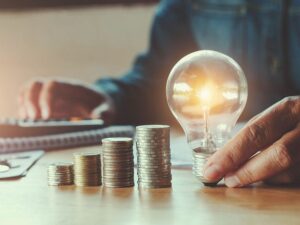Electricity consumption remains a significant environmental concern around the world. We still generate most of the electricity consumed from fossil fuel; oil, natural gas, and coal. We source the fuel for electricity generated this way below the ground surface, which usually requires collection using drilling and mining.
Becoming energy efficient at home can save money and also helps do your bit to cut down on emissions. All those appliances and lightbulbs may seem relatively insignificant, but they all add up. Saving electricity at home helps reduce your household need for energy, and in turn, helps reduce demand for polluting fossil fuel. What’s more, you’ll also save cash on your electric bills.
Energy conservation vs. energy efficiency
While energy conservation is the practice of trying to use less energy for cost and environmental reasons, energy efficiency means using specific products designed to use less energy. These two concepts are inherently similar, but involve different methods. Examples of energy conservation include using smart appliances and energy-saving bulbs in your home.
10 ways to save energy and electricity
1. Adjust your day-to-day behaviors
Energy conservation can be as simple as turning off lights or appliances when you do not need them. You can also use energy-intensive appliances less by performing household tasks manually, such as hang-drying your clothes instead of putting them in the dryer, or washing dishes by hand.
2. Replace your light bulbs
Traditional incandescent light bulbs consume an excessive amount of electricity and must be replaced more often than their energy efficient alternatives. Halogen incandescent bulbs, compact fluorescent lights (CFLs), and light-emitting diode bulbs (LEDs) use anywhere from 25-80 percent less electricity and last 3 to 25 times longer than traditional bulbs.
3. Purchase energy efficient appliances
When purchasing an energy efficient appliance, you should look for appliances with the ENERGY STAR label, which is a federal guarantee that the appliance will consume less energy during use and when on standby than standard models. Energy savings differ based on the specific appliance.
4. Reduce your water heating expenses
Water heating is a major contributor to your total energy consumption. Other than purchasing an energy efficient water heater, there are three methods of reducing your water heating expenses: you can simply use less hot water, turn down the thermostat on your water heater, or insulate your water heater and the first six feet of hot and cold water pipes.
5. Install energy efficient windows
Windows are a significant source of energy waste – they can add up to 10-25% of your total heating bill. To prevent heat loss through your windows, you can replace single-pane windows with double-pane products instead.
6. Upgrade your HVAC system
An HVAC system composed of heating, ventilation, and air conditioning equipment. Heating alone is responsible for more than 40% of home energy use. Because homes in Northern regions exposed to much colder temperatures during the year, ENERGY STAR gas furnaces have different specifications in the northern and southern halves of the United States.
7. Wash your clothes in cold water
Washing clothes is a necessary chore and part of the weekly routine of most Americans. It is also an energy-intensive one, especially if you use warm water. In fact, the majority of energy used during the clothes washing process goes towards warming water. There are even reports that washing in cold water can increase the lifespan of your clothes without damaging heat.
8. Replace your air filters
Many devices across your home use filters, including your HVAC system. These systems often come with displayed reminders to replace filters regularly. Doing so will not only help you avoid having to make costly repairs to your air conditioning, but could also save money. In fact, The Department of Energy released a report saying that replacing dirty filters regularly can reduce household energy consumption up to 15%. This is because clean filters are more efficient and put less strain on your system.
9. Use your microwave instead of your stove
Along with other household chores, reheating food is a necessary and also energy-taxing process. Depending on your preference, a stove may preserve the flavor of food a little better. Independent of taste, however, there is evidence to suggest that a microwave is more energy efficient. The nature of a stove makes it prone to losing energy. A microwave, while using a lot of electricity, uses relatively short bursts of power for small amounts of time.
10. Use natural light
Lighting accounts for a significant amount of energy costs, and using light from the sun is an intuitive way to reduce your energy consumption. If you can, it is better to have north and south-facing windows instead of east and west. This allows for more glancing light that produces heat and limits harsh light in the winter. While east and west-facing windows allow for more direct sunlight, they aren’t as effective at letting heat in.
Remember that there is a connection between how much electricity you use and your environment. Your personal electricity conservation changes might seem small, but they all add up.
Until the time when we can entirely depend on green energy sources, we can all contribute to our collective effort to preserve our natural resources and slow down the effect of global warming.
If you like this post, please share it with your friends. And if you like our blog, you should check our website. Also, we invite you to follow at Instagram, Facebook, Twitter, and Pinterest




